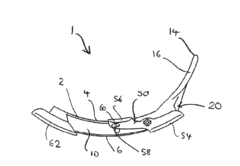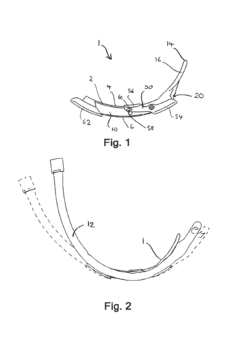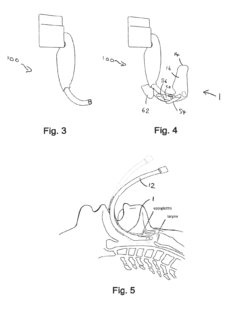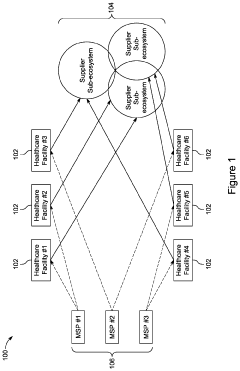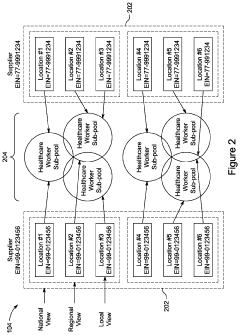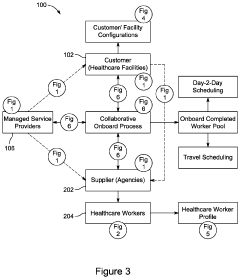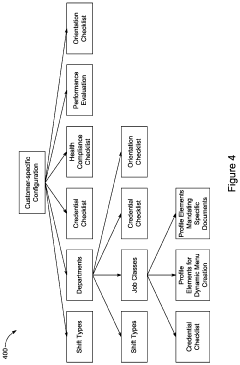Laryngoscope employment in smart healthcare ecosystems.
JUL 14, 20259 MIN READ
Generate Your Research Report Instantly with AI Agent
Patsnap Eureka helps you evaluate technical feasibility & market potential.
Laryngoscope Tech Evolution and Objectives
The laryngoscope, a crucial instrument in medical practice, has undergone significant evolution since its inception in the early 19th century. Initially designed for visual examination of the larynx, it has transformed into a sophisticated tool integral to modern healthcare ecosystems. The technological progression of laryngoscopes aligns with the broader trend of smart healthcare, incorporating advanced imaging, data processing, and connectivity features.
The primary objective of laryngoscope technology in smart healthcare ecosystems is to enhance diagnostic accuracy, improve patient outcomes, and streamline medical procedures. This involves integrating laryngoscopes with digital platforms, artificial intelligence, and telemedicine systems to create a more interconnected and efficient healthcare environment. The evolution of laryngoscopes aims to address challenges such as difficult airway management, remote diagnosis, and real-time data sharing among healthcare professionals.
Recent advancements in laryngoscope technology focus on miniaturization, improved image quality, and enhanced ergonomics. The introduction of video laryngoscopes has revolutionized the field, allowing for better visualization of the airway and facilitating easier intubation procedures. These devices often incorporate high-resolution cameras, LED lighting, and anti-fogging mechanisms to provide clear, real-time images of the larynx and surrounding structures.
Another significant objective in laryngoscope development is the integration of augmented reality (AR) and artificial intelligence (AI) capabilities. AR-enabled laryngoscopes can overlay critical anatomical information onto the live view, assisting practitioners in identifying structures and potential abnormalities. AI algorithms are being developed to analyze laryngoscopic images in real-time, potentially aiding in the early detection of laryngeal pathologies or guiding less experienced practitioners during procedures.
Connectivity and data management represent crucial aspects of laryngoscope evolution in smart healthcare ecosystems. Modern laryngoscopes are increasingly designed with wireless capabilities, allowing for seamless integration with hospital information systems and electronic health records. This connectivity enables real-time sharing of images and video feeds, facilitating remote consultations and collaborative decision-making among healthcare teams.
The ongoing technological evolution of laryngoscopes also aims to address the growing need for portable and versatile devices suitable for various healthcare settings. This includes the development of compact, battery-powered units that can be easily deployed in emergency situations or resource-limited environments. Such innovations align with the broader goal of expanding access to quality healthcare and improving emergency response capabilities.
As laryngoscope technology continues to advance, a key objective is to enhance its role in preventive healthcare and long-term patient monitoring. This involves developing laryngoscopes capable of capturing and analyzing data over time, potentially identifying trends or early warning signs of laryngeal disorders. The integration of these devices into broader health monitoring systems could contribute to more comprehensive and proactive patient care strategies.
The primary objective of laryngoscope technology in smart healthcare ecosystems is to enhance diagnostic accuracy, improve patient outcomes, and streamline medical procedures. This involves integrating laryngoscopes with digital platforms, artificial intelligence, and telemedicine systems to create a more interconnected and efficient healthcare environment. The evolution of laryngoscopes aims to address challenges such as difficult airway management, remote diagnosis, and real-time data sharing among healthcare professionals.
Recent advancements in laryngoscope technology focus on miniaturization, improved image quality, and enhanced ergonomics. The introduction of video laryngoscopes has revolutionized the field, allowing for better visualization of the airway and facilitating easier intubation procedures. These devices often incorporate high-resolution cameras, LED lighting, and anti-fogging mechanisms to provide clear, real-time images of the larynx and surrounding structures.
Another significant objective in laryngoscope development is the integration of augmented reality (AR) and artificial intelligence (AI) capabilities. AR-enabled laryngoscopes can overlay critical anatomical information onto the live view, assisting practitioners in identifying structures and potential abnormalities. AI algorithms are being developed to analyze laryngoscopic images in real-time, potentially aiding in the early detection of laryngeal pathologies or guiding less experienced practitioners during procedures.
Connectivity and data management represent crucial aspects of laryngoscope evolution in smart healthcare ecosystems. Modern laryngoscopes are increasingly designed with wireless capabilities, allowing for seamless integration with hospital information systems and electronic health records. This connectivity enables real-time sharing of images and video feeds, facilitating remote consultations and collaborative decision-making among healthcare teams.
The ongoing technological evolution of laryngoscopes also aims to address the growing need for portable and versatile devices suitable for various healthcare settings. This includes the development of compact, battery-powered units that can be easily deployed in emergency situations or resource-limited environments. Such innovations align with the broader goal of expanding access to quality healthcare and improving emergency response capabilities.
As laryngoscope technology continues to advance, a key objective is to enhance its role in preventive healthcare and long-term patient monitoring. This involves developing laryngoscopes capable of capturing and analyzing data over time, potentially identifying trends or early warning signs of laryngeal disorders. The integration of these devices into broader health monitoring systems could contribute to more comprehensive and proactive patient care strategies.
Smart Healthcare Market Analysis
The smart healthcare market has been experiencing significant growth in recent years, driven by technological advancements and increasing demand for efficient healthcare solutions. The global smart healthcare market size was valued at USD 195.57 billion in 2021 and is projected to reach USD 974.65 billion by 2030, growing at a CAGR of 19.6% during the forecast period.
The integration of laryngoscopes into smart healthcare ecosystems represents a key segment within this market. Laryngoscopes are essential medical devices used for examining the larynx and facilitating intubation procedures. The smart laryngoscope market is expected to witness substantial growth due to the rising prevalence of respiratory diseases and the increasing adoption of minimally invasive procedures.
North America currently dominates the smart healthcare market, accounting for the largest market share. This can be attributed to the region's advanced healthcare infrastructure, high healthcare expenditure, and early adoption of innovative medical technologies. However, the Asia-Pacific region is anticipated to exhibit the highest growth rate in the coming years, driven by improving healthcare infrastructure, increasing healthcare awareness, and rising disposable incomes.
The COVID-19 pandemic has further accelerated the adoption of smart healthcare solutions, including advanced laryngoscopes, as healthcare providers seek to minimize physical contact and improve patient outcomes. This has led to a surge in demand for telemedicine services and remote patient monitoring systems, which are expected to continue growing even in the post-pandemic era.
Key market players in the smart healthcare industry are focusing on product innovations and strategic collaborations to gain a competitive edge. Major companies operating in this space include Medtronic, Philips Healthcare, GE Healthcare, and Siemens Healthineers, among others. These companies are investing heavily in research and development to introduce advanced laryngoscope technologies that integrate seamlessly with smart healthcare ecosystems.
The market for smart laryngoscopes is witnessing a shift towards video laryngoscopes equipped with high-resolution cameras and real-time imaging capabilities. These devices offer improved visualization of the airway, enhancing the success rate of intubation procedures and reducing complications. Furthermore, the integration of artificial intelligence and machine learning algorithms in smart laryngoscopes is expected to revolutionize airway management practices, providing real-time guidance to healthcare professionals during critical procedures.
The integration of laryngoscopes into smart healthcare ecosystems represents a key segment within this market. Laryngoscopes are essential medical devices used for examining the larynx and facilitating intubation procedures. The smart laryngoscope market is expected to witness substantial growth due to the rising prevalence of respiratory diseases and the increasing adoption of minimally invasive procedures.
North America currently dominates the smart healthcare market, accounting for the largest market share. This can be attributed to the region's advanced healthcare infrastructure, high healthcare expenditure, and early adoption of innovative medical technologies. However, the Asia-Pacific region is anticipated to exhibit the highest growth rate in the coming years, driven by improving healthcare infrastructure, increasing healthcare awareness, and rising disposable incomes.
The COVID-19 pandemic has further accelerated the adoption of smart healthcare solutions, including advanced laryngoscopes, as healthcare providers seek to minimize physical contact and improve patient outcomes. This has led to a surge in demand for telemedicine services and remote patient monitoring systems, which are expected to continue growing even in the post-pandemic era.
Key market players in the smart healthcare industry are focusing on product innovations and strategic collaborations to gain a competitive edge. Major companies operating in this space include Medtronic, Philips Healthcare, GE Healthcare, and Siemens Healthineers, among others. These companies are investing heavily in research and development to introduce advanced laryngoscope technologies that integrate seamlessly with smart healthcare ecosystems.
The market for smart laryngoscopes is witnessing a shift towards video laryngoscopes equipped with high-resolution cameras and real-time imaging capabilities. These devices offer improved visualization of the airway, enhancing the success rate of intubation procedures and reducing complications. Furthermore, the integration of artificial intelligence and machine learning algorithms in smart laryngoscopes is expected to revolutionize airway management practices, providing real-time guidance to healthcare professionals during critical procedures.
Current Laryngoscope Tech Challenges
The current challenges in laryngoscope technology within smart healthcare ecosystems are multifaceted and require innovative solutions to enhance patient care and clinical outcomes. One of the primary challenges is the integration of advanced imaging technologies into traditional laryngoscope designs. While high-definition cameras have been incorporated into some models, there is a pressing need for real-time image processing and augmented reality overlays to assist clinicians in identifying abnormalities more accurately.
Another significant challenge lies in the development of more ergonomic and user-friendly designs. Current laryngoscopes can be cumbersome to manipulate, especially in difficult intubation scenarios. This issue is compounded by the need for single-use devices to prevent cross-contamination, which often results in less refined ergonomics compared to reusable counterparts.
The integration of laryngoscopes into broader smart healthcare ecosystems presents its own set of challenges. Interoperability with existing hospital information systems and electronic health records remains a hurdle. Seamless data transfer and storage of laryngoscopic images and videos, while maintaining patient privacy and data security, is an ongoing concern that requires robust solutions.
Power management and battery life present another technical challenge, particularly for wireless laryngoscopes. The demand for longer operating times and quick charging capabilities must be balanced with the need for compact, lightweight designs suitable for portable use in various clinical settings.
Artificial intelligence and machine learning integration into laryngoscope systems is an emerging area with significant potential but also substantial challenges. Developing algorithms that can accurately assist in the detection of pathologies or guide intubation in real-time requires extensive training data and validation processes.
Environmental sustainability is becoming an increasingly important consideration. The healthcare industry's reliance on single-use plastic devices, including disposable laryngoscope blades, contributes to medical waste. Developing eco-friendly materials that meet stringent medical standards for sterility and durability is a complex challenge that researchers are actively addressing.
Lastly, the cost-effectiveness of advanced laryngoscope technologies remains a significant barrier to widespread adoption in many healthcare settings. Balancing the incorporation of cutting-edge features with affordability is crucial for ensuring that these innovations can benefit a broad range of patients and healthcare providers across different economic contexts.
Another significant challenge lies in the development of more ergonomic and user-friendly designs. Current laryngoscopes can be cumbersome to manipulate, especially in difficult intubation scenarios. This issue is compounded by the need for single-use devices to prevent cross-contamination, which often results in less refined ergonomics compared to reusable counterparts.
The integration of laryngoscopes into broader smart healthcare ecosystems presents its own set of challenges. Interoperability with existing hospital information systems and electronic health records remains a hurdle. Seamless data transfer and storage of laryngoscopic images and videos, while maintaining patient privacy and data security, is an ongoing concern that requires robust solutions.
Power management and battery life present another technical challenge, particularly for wireless laryngoscopes. The demand for longer operating times and quick charging capabilities must be balanced with the need for compact, lightweight designs suitable for portable use in various clinical settings.
Artificial intelligence and machine learning integration into laryngoscope systems is an emerging area with significant potential but also substantial challenges. Developing algorithms that can accurately assist in the detection of pathologies or guide intubation in real-time requires extensive training data and validation processes.
Environmental sustainability is becoming an increasingly important consideration. The healthcare industry's reliance on single-use plastic devices, including disposable laryngoscope blades, contributes to medical waste. Developing eco-friendly materials that meet stringent medical standards for sterility and durability is a complex challenge that researchers are actively addressing.
Lastly, the cost-effectiveness of advanced laryngoscope technologies remains a significant barrier to widespread adoption in many healthcare settings. Balancing the incorporation of cutting-edge features with affordability is crucial for ensuring that these innovations can benefit a broad range of patients and healthcare providers across different economic contexts.
Smart Laryngoscope Solutions
01 Improved visualization and illumination
Modern laryngoscopes incorporate advanced lighting and imaging technologies to enhance visibility during intubation procedures. These improvements may include LED lights, fiber optic systems, or video cameras to provide clearer views of the larynx and surrounding structures, facilitating easier and more accurate intubation.- Improved visualization and illumination: Modern laryngoscopes incorporate advanced lighting and imaging technologies to enhance visibility during intubation procedures. These improvements may include LED lighting, fiber optic systems, or integrated cameras to provide clearer views of the larynx and surrounding structures.
- Disposable and sterile components: To reduce the risk of cross-contamination and improve hygiene, many laryngoscopes now feature disposable blades or sheaths. These single-use components can be easily replaced between patients, ensuring a sterile environment for each procedure.
- Ergonomic design and handling: Laryngoscopes are being designed with improved ergonomics to enhance user comfort and control during intubation. This may include adjustable handles, lightweight materials, and optimized blade shapes to facilitate easier insertion and manipulation.
- Integration of video and digital technologies: Video laryngoscopes incorporate small cameras and screens to provide real-time visual feedback during intubation. These devices may also include features such as image capture, recording capabilities, and connectivity options for training and documentation purposes.
- Specialized blade designs: Various blade designs have been developed to address specific anatomical challenges or patient populations. These may include curved or straight blades, adjustable-angle blades, or blades designed for difficult airways or pediatric use.
02 Disposable and sterile components
To reduce the risk of cross-contamination and improve hygiene, many laryngoscopes now feature disposable blades or sheaths. These single-use components ensure a sterile environment for each patient and simplify the cleaning and maintenance process for healthcare providers.Expand Specific Solutions03 Ergonomic design and handling
Laryngoscopes are being designed with improved ergonomics to enhance user comfort and control during procedures. This includes features such as adjustable handles, lightweight materials, and balanced weight distribution to reduce hand fatigue and improve maneuverability.Expand Specific Solutions04 Integration of advanced sensors and monitoring
Some laryngoscopes now incorporate sensors and monitoring capabilities to provide real-time feedback during intubation. These may include pressure sensors to detect contact with tissues, oxygen saturation monitors, or even augmented reality displays to guide the procedure and improve safety.Expand Specific Solutions05 Specialized blade designs
Laryngoscope blades are being developed in various shapes and sizes to accommodate different patient anatomies and specific clinical scenarios. These specialized designs may include curved or straight blades, adjustable angles, or blades optimized for difficult airways or pediatric patients.Expand Specific Solutions
Key Smart Laryngoscope Manufacturers
The laryngoscope market in smart healthcare ecosystems is in a growth phase, driven by increasing demand for advanced airway management tools. The global market size is expanding, with key players like Ambu A/S, Verathon, and Covidien AG leading innovation. Technological advancements are pushing the industry towards more sophisticated, video-enabled devices. Companies like Zhejiang Youyi Medical Equipment and Lanjia Medical are emerging with novel solutions, indicating a trend towards smart, connected laryngoscopes. The competitive landscape is diverse, with established medical device manufacturers competing alongside specialized airway management companies and innovative startups, reflecting the market's dynamic nature and potential for further growth.
Covidien AG
Technical Solution: Covidien, now part of Medtronic, has developed the McGrath MAC video laryngoscope for use in smart healthcare ecosystems. The system features a compact design with a high-resolution camera and screen integrated into the handle. The McGrath MAC utilizes disposable blades in various sizes to accommodate different patient anatomies[6]. Covidien has also introduced the Nellcor video laryngoscope, which incorporates SpO2 monitoring capabilities to provide real-time oxygenation data during intubation procedures[7]. The company's laryngoscope solutions integrate with broader patient monitoring systems, allowing for comprehensive data collection and analysis in smart healthcare environments.
Strengths: Integration of video laryngoscopy with patient monitoring capabilities provides a more comprehensive approach to airway management. Weaknesses: Limited range of specialized blades compared to some competitors.
Flexicare (Group) Ltd.
Technical Solution: Flexicare has developed the Vividtrac VT-A100, a single-use video laryngoscope designed for use in smart healthcare ecosystems. The system features a compact, all-in-one design with an integrated screen and camera. Flexicare's laryngoscope utilizes a unique bougie channel to facilitate endotracheal tube placement in difficult airways[10]. The company has also introduced the FVC100 Flexible Video Laryngoscope, which combines the benefits of flexible and video laryngoscopy for challenging intubations[11]. Flexicare's laryngoscope solutions are designed to be compatible with existing hospital IT systems, allowing for easy integration into smart healthcare workflows and data management processes.
Strengths: Innovative designs combining multiple airway management techniques in single devices. Weaknesses: Smaller product range compared to some larger competitors in the laryngoscope market.
Core Laryngoscope AI Innovations
Insertion section for laryngoscope with lateral tube guide
PatentActiveUS20160317011A1
Innovation
- A laryngoscope insertion section with a tube guide that retains the endotracheal tube in a plane, with the viewing port laterally offset, allowing the tube to be advanced distally without lateral curvature, aligning with the patient's median plane for easier and more confident insertion.
Managed service provider system for collaborative healthcare credentialing, compliance, and scheduling across shared suppliers
PatentInactiveUS10832810B2
Innovation
- A managed service provider (MSP) system that integrates credentialing, compliance, and scheduling across multiple healthcare facilities and suppliers, enabling real-time monitoring, automated workflows, and dynamic scheduling, with features like virtual calendars, multidimensional scheduling views, and automated timecard generation to ensure compliance and efficient staffing.
Telemedicine Integration Strategies
The integration of laryngoscopes into telemedicine strategies within smart healthcare ecosystems represents a significant advancement in remote patient care and diagnosis. This integration enables healthcare providers to perform remote laryngeal examinations, enhancing the scope and effectiveness of telemedicine services.
One key strategy for integrating laryngoscopes into telemedicine is the development of wireless, portable laryngoscope devices that can transmit high-quality images and videos in real-time. These devices often incorporate advanced imaging technologies such as high-definition cameras and LED lighting systems, allowing for detailed visualization of the larynx and surrounding structures.
Secure data transmission is crucial in telemedicine integration. Implementing end-to-end encryption and compliance with healthcare data protection regulations ensures that patient information and examination results are transmitted safely. This is particularly important when integrating laryngoscopes into existing telemedicine platforms and electronic health record systems.
Another important aspect of integration is the development of user-friendly interfaces for both healthcare providers and patients. Intuitive software applications that guide users through the examination process can significantly improve the accuracy and efficiency of remote laryngoscopic examinations.
Artificial intelligence and machine learning algorithms play a vital role in enhancing the diagnostic capabilities of telemedicine-integrated laryngoscopes. These technologies can assist in image analysis, potentially identifying abnormalities or areas of concern that may require further investigation by a specialist.
Training and education programs for healthcare providers are essential for successful integration. These programs should focus on the proper use of telemedicine-enabled laryngoscopes, interpretation of remote examination results, and effective communication with patients during virtual consultations.
Interoperability is a critical consideration in telemedicine integration strategies. Ensuring that laryngoscope devices and associated software can seamlessly integrate with various telemedicine platforms and healthcare information systems is crucial for widespread adoption and effectiveness.
Lastly, developing protocols for remote patient preparation and guidance during laryngoscopic examinations is vital. Clear instructions and real-time communication capabilities can help patients position themselves correctly and cooperate effectively during the examination, improving the quality and reliability of the results.
One key strategy for integrating laryngoscopes into telemedicine is the development of wireless, portable laryngoscope devices that can transmit high-quality images and videos in real-time. These devices often incorporate advanced imaging technologies such as high-definition cameras and LED lighting systems, allowing for detailed visualization of the larynx and surrounding structures.
Secure data transmission is crucial in telemedicine integration. Implementing end-to-end encryption and compliance with healthcare data protection regulations ensures that patient information and examination results are transmitted safely. This is particularly important when integrating laryngoscopes into existing telemedicine platforms and electronic health record systems.
Another important aspect of integration is the development of user-friendly interfaces for both healthcare providers and patients. Intuitive software applications that guide users through the examination process can significantly improve the accuracy and efficiency of remote laryngoscopic examinations.
Artificial intelligence and machine learning algorithms play a vital role in enhancing the diagnostic capabilities of telemedicine-integrated laryngoscopes. These technologies can assist in image analysis, potentially identifying abnormalities or areas of concern that may require further investigation by a specialist.
Training and education programs for healthcare providers are essential for successful integration. These programs should focus on the proper use of telemedicine-enabled laryngoscopes, interpretation of remote examination results, and effective communication with patients during virtual consultations.
Interoperability is a critical consideration in telemedicine integration strategies. Ensuring that laryngoscope devices and associated software can seamlessly integrate with various telemedicine platforms and healthcare information systems is crucial for widespread adoption and effectiveness.
Lastly, developing protocols for remote patient preparation and guidance during laryngoscopic examinations is vital. Clear instructions and real-time communication capabilities can help patients position themselves correctly and cooperate effectively during the examination, improving the quality and reliability of the results.
Data Privacy in Smart Laryngoscopy
Data privacy in smart laryngoscopy is a critical concern as healthcare systems increasingly integrate advanced technologies. The use of smart laryngoscopes in medical procedures generates sensitive patient data that requires robust protection measures. These devices often capture high-resolution images and videos of patients' airways, which are then transmitted and stored within healthcare networks.
One of the primary challenges in ensuring data privacy for smart laryngoscopy is secure data transmission. As these devices often operate within wireless networks, there is an inherent risk of data interception during transmission. Implementing end-to-end encryption protocols is essential to safeguard patient information from unauthorized access or breaches.
Storage of laryngoscopy data presents another significant privacy concern. Healthcare institutions must establish secure data storage systems with stringent access controls. This includes implementing multi-factor authentication for medical personnel accessing patient records and maintaining detailed audit logs of data access and usage.
Compliance with healthcare data protection regulations, such as HIPAA in the United States or GDPR in Europe, is paramount. Smart laryngoscopy systems must be designed and operated in accordance with these regulatory frameworks to ensure patient privacy rights are upheld and to avoid potential legal repercussions.
The integration of artificial intelligence and machine learning algorithms in smart laryngoscopy introduces additional privacy considerations. These technologies often require large datasets for training and optimization, which may involve the use of anonymized patient data. Ensuring proper de-identification techniques are employed is crucial to prevent potential re-identification of individuals from these datasets.
Consent management is another vital aspect of data privacy in smart laryngoscopy. Healthcare providers must obtain informed consent from patients regarding the collection, use, and storage of their laryngoscopy data. This includes clear communication about how the data will be used, who will have access to it, and for how long it will be retained.
As smart laryngoscopes become more interconnected within broader healthcare ecosystems, the risk of data breaches increases. Implementing robust cybersecurity measures, including regular security audits, vulnerability assessments, and incident response plans, is essential to protect patient privacy and maintain the integrity of healthcare systems.
One of the primary challenges in ensuring data privacy for smart laryngoscopy is secure data transmission. As these devices often operate within wireless networks, there is an inherent risk of data interception during transmission. Implementing end-to-end encryption protocols is essential to safeguard patient information from unauthorized access or breaches.
Storage of laryngoscopy data presents another significant privacy concern. Healthcare institutions must establish secure data storage systems with stringent access controls. This includes implementing multi-factor authentication for medical personnel accessing patient records and maintaining detailed audit logs of data access and usage.
Compliance with healthcare data protection regulations, such as HIPAA in the United States or GDPR in Europe, is paramount. Smart laryngoscopy systems must be designed and operated in accordance with these regulatory frameworks to ensure patient privacy rights are upheld and to avoid potential legal repercussions.
The integration of artificial intelligence and machine learning algorithms in smart laryngoscopy introduces additional privacy considerations. These technologies often require large datasets for training and optimization, which may involve the use of anonymized patient data. Ensuring proper de-identification techniques are employed is crucial to prevent potential re-identification of individuals from these datasets.
Consent management is another vital aspect of data privacy in smart laryngoscopy. Healthcare providers must obtain informed consent from patients regarding the collection, use, and storage of their laryngoscopy data. This includes clear communication about how the data will be used, who will have access to it, and for how long it will be retained.
As smart laryngoscopes become more interconnected within broader healthcare ecosystems, the risk of data breaches increases. Implementing robust cybersecurity measures, including regular security audits, vulnerability assessments, and incident response plans, is essential to protect patient privacy and maintain the integrity of healthcare systems.
Unlock deeper insights with Patsnap Eureka Quick Research — get a full tech report to explore trends and direct your research. Try now!
Generate Your Research Report Instantly with AI Agent
Supercharge your innovation with Patsnap Eureka AI Agent Platform!
